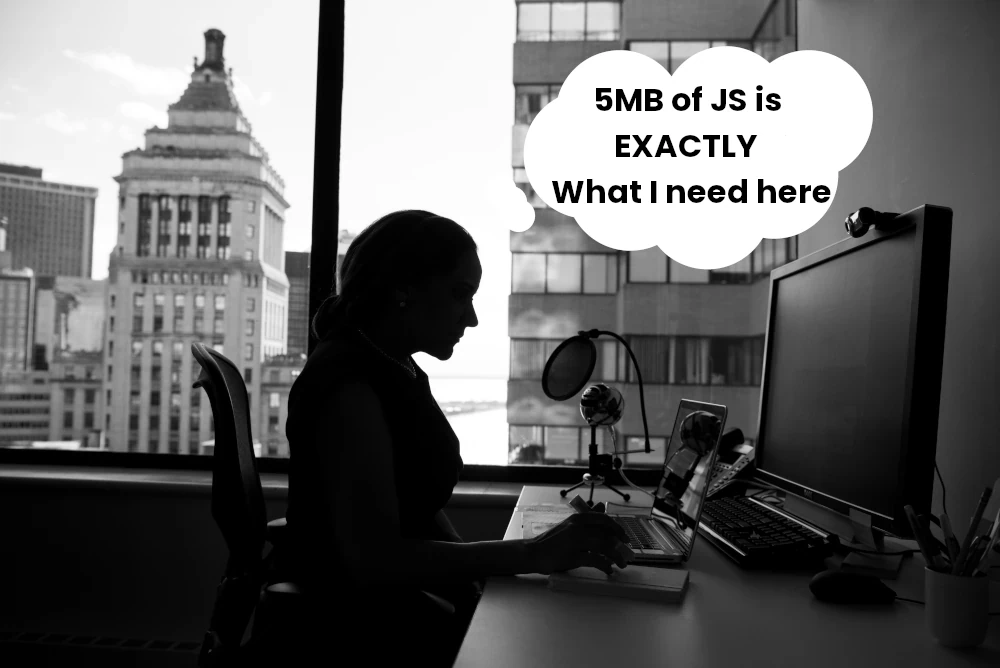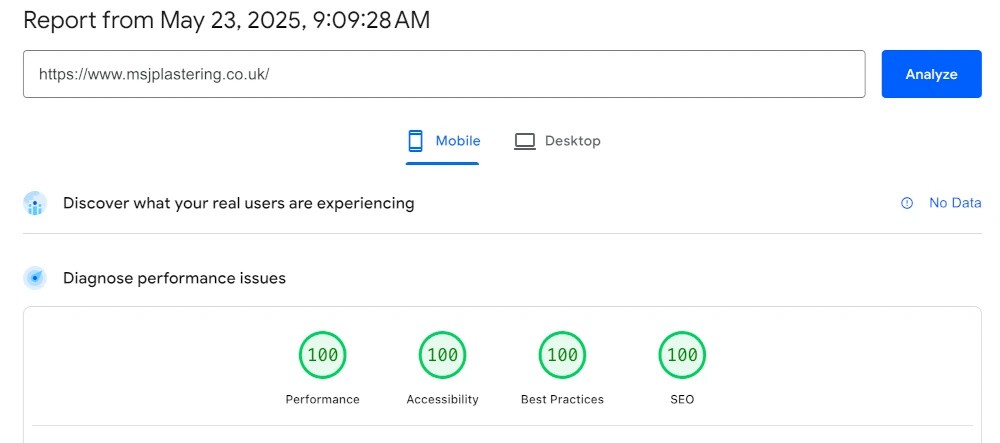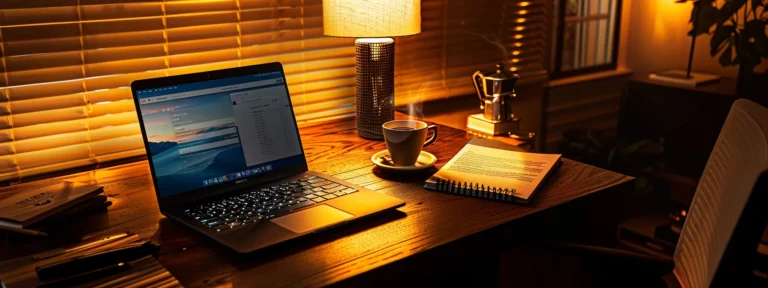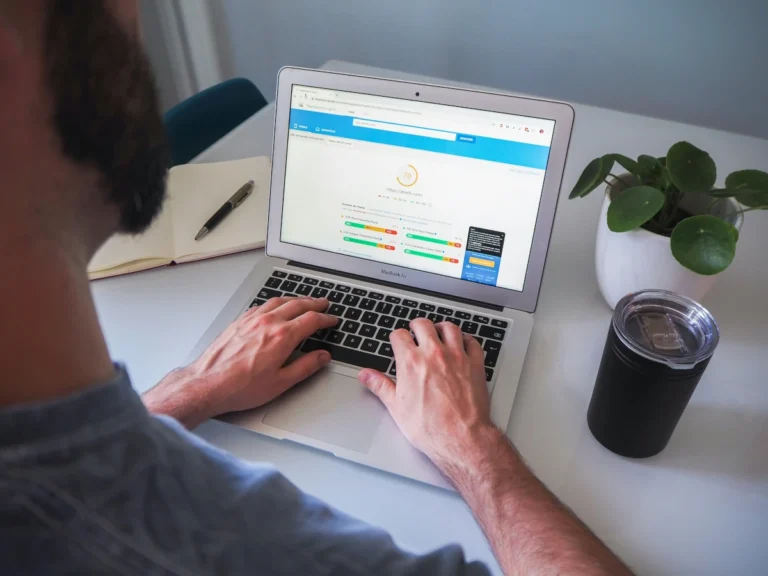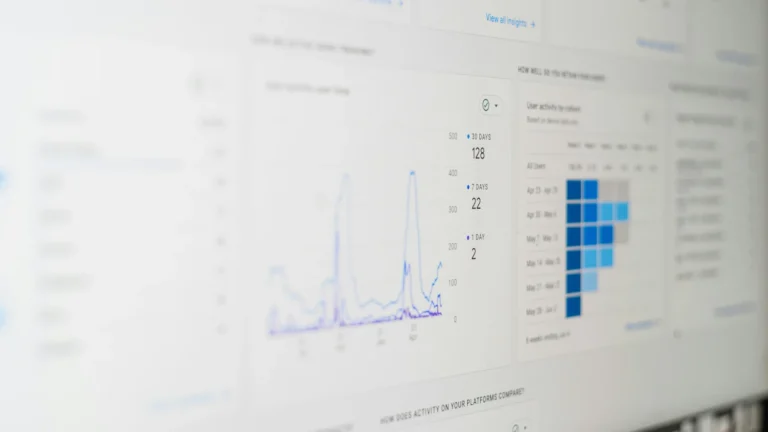“How Do I Find a Good Web Designer? I know I need a website.. but I’ve come to the conclusion that you’d probably be wise to have someone make this for me… but how do I know who’s good and who isn’t…?”
This blog post aims to help you find a web designer who can make you the site you need, and how you can get an idea if they’ll be able to deliver what you require.
Before you start looking for a web designer.
Before you start looking for a web designer, there are some sensible things that you can do to help avoid, or at least mitigate, potential unwanted situations.
Register a domain.
Register a domain to keep control of your brand… and your traffic. Your domain isn’t just representative of your brand. It also controls where your emails arrive, and where requests for your website are sent. In the event that everything goes horribly wrong, you can’t be completely held to ransom if you control your own domain registration.
Buy your own hosting.
Buying your own web hosting puts you in control of where your website, and possibly your email data is stored. Although you will need to give your website designer access to this for them to be able to deploy a website, if everything turns in to a disaster, you can lock them out. Again, your data can’t be held to ransom, if you control your own hosting.
Make sure you control both your domain and your web hosting.
Controlling your own domain and hosting is really a bit like digital estate insurance. While this does mean that you have to do things like manage passwords, and pay bills on time, it stops you from being at the mercy of a third party. Although this doesn’t happen very often, not even taking the chance that it might is the best possible course of action that can be taken as an initial measure.
What some web designers will say about you having your own hosting.
When you start talking to a web designer about having a site made, some of them will ask if you already have a domain and hosting. If you say yes, some web designers will say something like “we like the websites we make to be hosted by ourselves”.
The first thing that I should point out here, is that this isn’t a requirement of having a website.
Whilst some hosting is better than others as far as performance goes, this is fairly marginal for a small business portfolio type website. It might be more of a concern of you’re looking to have an e-commerce website, but generally speaking most hosting will be OK for most new business type websites.
In many cases web designers will make “the website needs to hosted with us” noises possibly because they’re used to using their own hosting (which may raise further questions regarding their administration abilities), they want to be able to hold your website data, or because they want to be able to charge you an ongoing cost.
The ongoing cost side of things is probably the most understandable, as business have to function by generating revenue in an ongoing manner. Other factors may be a red flag… or a slightly pink flag.
I’d recommend being slightly careful about controlling your hosting.
If you’d rather not have to think about anything, then your web designer hosting your site might well be a good course of action.
That’s the worrying part done!
Identify the purpose of your website.
Usually the primary purpose of having a website is to gain new business. If you follow all the ins and outs, and requirements any business has for a website, it almost always boils down to new customers, more sales, and more money. This post is mostly orientated to this type of website, so you may need to take that in to account when reading this article.
Your new website needs to be found online.
There’s not much point in having a website if it can’t be found online. You could have the most beautiful website in the world, but if it can’t be found when people search for related terms, your website won’t receive many visitors.
SEO (search engine optimisation) is what results in your website being found online. Whoever you choose to create your website is either going to need to provide this, or you’ll need to involve an additional party if they don’t.
Your new website needs to look appealing to potential customers.
Your website needs to look nice enough to attract customers, it needs to contain content that engages visitors, and it needs to perform well enough to stop people navigating away from your website.
You could have a website that’s at the top of page one of google, but if it doesn’t fulfil the criteria above, people might look at it, but they won’t look at it for long. Or long enough to arrive at the contact page.
There’s not much point in paying for a website if it can’t be found easily and if it doesn’t result in generating revenue. The points above are the bare minimum you’ll require in a website if you’d like to gain additional revenue.
Searching for a web designer.
Using the internet to search for a web designer is a good place to start. Although this sounds like a very obvious statement to make, this isn’t always people do.
You can simply search for things like:
- Web designers near me
- Web designers followed by the first part of your post code
Look at some website designer’s websites, see what you think, then maybe contact a few people and set up a meeting.
Does their website look nice?
If a web designer’s website doesn’t visually appeal to you, they’re probably not going to make a website that suits your tastes.
If a web designer’s website takes a long time to load, a website they make you may do the same.
There can be exceptions, and it may be worth checking past examples of websites in the designer’s past website portfolio to see if this is the case. That said, if someone you’re looking in to hasn’t made a nice looking website, what makes you think they’ll make you a nice looking website?
If you’re in any way put off by the website designers website (or websites they’ve made), move on, find someone else.
There’s more on how to check websites in a web designers portfolio down there.
Was the website designer’s website easy to find?
If you’ve found a website designer easily by searching in Google, that’s a a good sign, especially as far as SEO is concerned. Website design is quite a saturated market, so finding someone on page two or page three of Google is OK. Page six isn’t where web designers should be, though.
Pitfalls to avoid.
If you have a web designer recommended to you by a friend, but you can’t find them online, this isn’t a good sign. If they can’t be found online, why would the website they make you be found online.
If your next door neighbours nephew can “probably make you a website”, ask the person that’s said this if the nephew is a website designer, or if they work in SEO. There’s a huge gap between putting some words and pictures on the internet, and deploying a revenue generating website. To put things in perspective, it took me a WHOLE YEAR to work out how to make a visually appealing, well performing website that can be found easily in Google, and I work here. And I’ve also been working in IT since the late 90s and I’ve also had involvement with running websites in multiple job roles. It’s not easy to tick all the boxes. Why should you wait while someone’s nephew works it out? You shouldn’t. Ask then to get back to you AFTER they’ve worked it out.
Look at web designer’s portfolios.
On many website designers websites, they’ll show a portfolio of websites that they’ve made. You can use these to get an idea of the website you might end up with if you have a look at some of these websites.
Do the websites look nice?
Do the websites in the portfolio look appealing to you? They do? That’s good!
Do the websites in the portfolio all look the same? This means the designer is probably using some kind of template. They’ll probably do that if they make you a website as well. A website designer thinking that it’s OK to do this and to show it off in their portfolio may also give you an idea of their character. That’s about the nicest way I can think to put that.
If you look at a website designer’s portfolio and you think the sites look great, that’s a really good sign, but it’s by no means all there is to it.
Can you find the companies in the portfolio by searching to them?
Let’s say there’s a website in the portfolio that’s a plumber in Leeds. Can you find them by searching for “plumber in Leeds” in google? Which page are they on?
Carrying out searches for the businesses in the portfolio is a good way to get an idea of how easy a website this designer makes you will be to find.
If you don’t find the company by searching for the name of that company, that’s quite a big red flag.
If you can’t find the company by searching for the business demographic and town or city, this is a bit worrying. That said if the town or city is very large (Birmingham for example), there will be a greater amount of competition. You could try localising your search criteria to smaller and smaller areas (district, locality etc) to see if the company can be found.
If you find the company immediately in google for similar criteria you’d like your website to be found for this is a VERY good sign. SEO can be one of the harder aspects of website design, so if a web designer is achieving in this capacity, it’s a big plus.
A word of warning about SEO.
SEO can have an ongoing cost. This can add up to quite a lot.
Some web designers might only carry out minimal SEO effort on your initial website build. Then if you ask about SEO or the lack of ranking in search results (most likely as a result of a lack of customer contact), the website designer will start trying to sell you SEO services, such as pay per click or adword campaigns.
Whilst adword and pay per click campaigns are a legitimate SEO methodology, these aren’t required to rank well in search engine results for local searches. It’s entirely possible to rank well if you’re appealing to a local audience with decent content, website performance, and a well laid out site.
If a website designer tells you that you HAVE to use adwords or pay per click to rank in local search results, this can be an indication that they don’t really know how so effectively optimise a website for search engines. The fix that most designers of this nature apply is a money orientated approach, that will cost you, usually involving adword and pay per click campaigns.
If you’re looking to appeal to a national audience, or one that’s greater than your immediate locality, you may well have to involve some kind of money specific SEO effort to achieve this.
As you can probably tell SEO is quite variable according to your business, your audience, the amount of competition you have and what your competitors are doing.
The best advice I can really give you is to ask about what SEO is included in the initial build, and if there’s any ongoing costs. If a website designer immediately tells you that you have to pay for SEO in an ongoing manner, without having asked you about your business, you’d be wise to be a little wary. Obtaining an idea of costs, and what these are likely yo achieve is strongly advisable.
Tools that can help you tell if a web designer is any good.
When assessing a website designers website, or website portfolio, there are some online tools you can use to see how good the site is. Different tools can be used to assess different aspects of the website, such as performance and SEO.
Pagespeed insights.
Pagespeed insights is google’s website auditing tool. It “reports on the user experience of a page on both mobile and desktop devices, and provides suggestions on how that page may be improved.”
If you run a page made by a website designer through page speed insights you’ll see 4 metrics at the top of the audit results. This is an example of some good results:
Where as this is an example of some bad results:
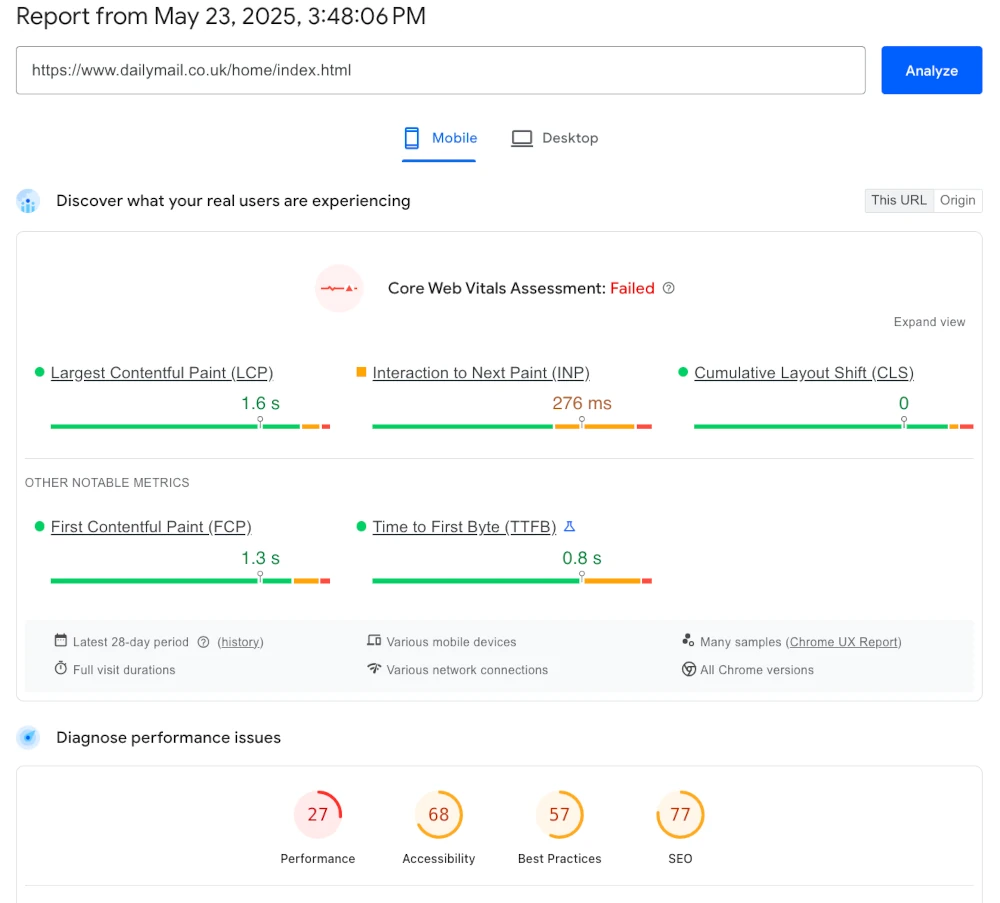
The traffic light like marking scheme can be used to give you a quick overview.
The SEO, best practices and accessibility metrics are all quite “the basics that should be done”. The performance metric (the one on the left) is the one that’s hard to ace.
This performance metric is more key than you might think. It’s more than just how fast a page loads (or more accurately; how fast a page can be rendered by a browser). This metric is a collection of assessments that make up what are called “core web vitals”. The situation is roughly that your website needs to pass core web vitals to rank in google search results. If you don’t see a reasonable performance metric in page speed insights, it’s possible that your website will be harder to find in google… especially if your competitors have websites with good performance metrics.
SEO analysis tools.
SEO analysis tools, such as seoptimer.com or seositecheckup.com can be used to gain an SEO overview of a website.
As pagespeed insights only gives you “the basics” SEO audit, you’ll have to use different tools to check “how good” the SEO of a site is. There are different aspects to SEO, such as your social media presence, and your website’s backlink profile.
Not all website designers will cover all aspects of what these tools asses (especially social media) so you might need to take that into account when using these tools.
On a more helpful note, if you use SEO tools and all assessments are poor, with none being good, that doesn’t bode particularly well for gaining an effective easily found websites.
What you can check on the websites themselves.
There are also a few things you can check on a website to see how good it is.
The favicon.
The favicon is the icon on the browser tab. What you really should be seeing here is a custom favicon, one that’s specific to the business the website is for, such as a company logo.
If instead you see a WordPress icon, or an icon that’s the site builder or the site builder company used to make the site this isn’t a great sign.
A custom favicon isn’t very difficult to sort out. Although it’s a fairly minor detail, if a website designer doesn’t make sites with custom favicons, they’re likely to be overlooking other fairly minor details as well. Enough minor details being overlooked can add up to bigger problems. It’s a bit like buying a suit from a tailor that doesn’t tuck their shirt in, then wondering why the suit doesn’t quite fit correctly.
Overall website experience.
A general feel of things is quite a good indicator of things. If you find yourself thinking things like “ooh, I like that” and “this is easy to use, and navigate” this is promising. On the other hand if you see page elements moving around on the page as it loads and you can’t find the contact page, this isn’t a good sign.
Be a bit fussy, it pays dividends compared to a “that will do” type approach.
When you find a web designer you think you might use…
When you find a website designer that you think you might use, there are a couple of things that will contribute to knowing how good they’ll be.
Use the contact form to contact the website designer.
Use the contact form on the designer’s website to contact them. If there is no contact form, the contact form errors, or you don’t hear back from them, think of this as destiny or a bullet dodged. You’ll probably need a contact form on your website, and if you do you’ll want it to work… but if the contact form on the web designer’s website doesn’t work, you might well experience similar problems if that same designer makes a website for you.
Good questions to ask:
- How much will this cost?
- What do I get for that cost?
- Is SEO included?
- What sort of rankings can I expect?
- What benefits have your customers gained from their website?
- Is SEO included, and what does that cover?
- How do you inline your critical CSS and defer non-critical assets?
I added the last one as a joke, but it is actually quite a good question to ask. If someone tells you exactly how they do this, they know their stuff! If someone says, something like “I use a caching plugin it does this for me”, while this sounds like a cheat it tells you that they know enough to appreciate why there might be the need to do this, and how to go about doing it. If there’s a long awkward pause, this might be because you’re talking to someone that’s more design orientated. Design orientated developers are sometimes able to create sites with good SEO, but in most cases, you’ll find yourself paying for adword campaigns.
The more questions the better. Ask about what’s important to you, as it is, after all, your website you’re asking about.
A word about website pricing.
Pricing isn’t the be all and end all, and it’s not always the case that the more you pay, the better the website will be.
Some people make websites in addition to their day jobs. People who do this can be a mixed bag. That said, if you’re dealing with someone that works in web hosting that makes websites on the side, you might find you get a killer bargain of a well performing, one of cost, high ranking website for a low cost. Not that I know anyone like that, honest. The downside of using people like this is that they’re not at your beck and call, they can take a bit longer to publish a website, and they might not be as responsive to your communications compared to full time web developers.
A lot of website designers are sole traders. These people don’t have financial weight of having to run a full company. Although they can be a bit of a mixed bag in terms of what their skills are and where their strengths lie, they can be very good value for the types of websites they provide. That said, there can be some more devious types amongst them, so make sure you check people like this out properly.
Website creation companies tend to be either really good or really bad. They’re usually more expensive as they have the financial overhead of running a company to cover, and they may well try and sell you subscription services due to these cost. The really good companies of this nature tend to have one person that does the design, another that does the SEO and another that’s a tech that does the bit everyone else hates. Companies arranged like this allow for higher degrees of specialisation so you’re likely to get an improved level of service and a decent website due to this. That said, just because a website design company employs multiple staff it’s not an indication that this specialisation is taking place, and it’s entirely possible that you could be dealing with an expensive company the doesn’t provide you with a great website… which is really why I wrote all this.
In conclusion…
Checking website designers sites and how appealing they are to you can be a good initial step to take when looking for a website designer.
Checking website designer’s portfolios can give you a good idea about the type of site you might be able to obtain.
There are various online tools that can be used to asses the quality of a website from a performance and SEO perspective.
There’s not a direction relationship between price and quality when it comes to websites.

